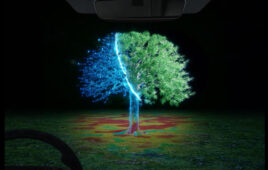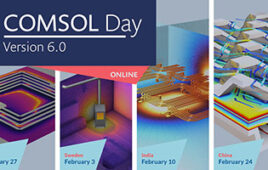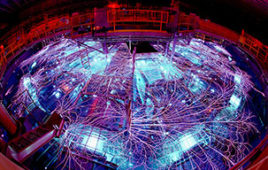
Following a blueprint created by UC Berkeley physicist Norman Yao, physicists at the University of Maryland made the first time crystal using a one-dimensional chain of ytterbium ions. Each ion behaves like an electron spin and exhibits long-range interactions indicated by the arrows. Credit: Chris Monroe, University of Maryland
Scientists have unveiled time crystals as the latest new form of matter.
Norman Yao, an assistant professor of physics from the University of California-Berkley, said the inert crystals have an atomic structure that repeats in space, like the carbon lattice of a diamond.
Yao was able to outline exactly how to make and measure the properties of a crystal and even predicts what the various phases surrounding the time crystal should be—akin to the liquid and gas phases of ice.
Following Yao’s hypothesis, groups from the University of Maryland and Harvard University found success in creating time crystals, using two completely different setups. Yao assisted both groups in their studies.
Time crystals repeat in time and returns to a similar configuration at regular intervals, while a standard crystal repeats in a regular spatial pattern.
According to Yao, the important discovery about the time crystal is that they are the first of a large class of new materials that are intrinsically out of equilibrium, unable to settle down to the motionless equilibrium of a diamond or a ruby.
“This is a new phase of matter, period, but it is also really cool because it is one of the first examples of non-equilibrium matter,” Yao said. “For the last half-century, we have been exploring equilibrium matter, like metals and insulators.
“We are just now starting to explore a whole new landscape of non-equilibrium matter.”
The time crystal created at the University of Maryland utilized 10 ytterbium ions, whose electron spins interact, similar to the qubit systems being tested as quantum computers.
The researchers kept the ions out of equilibrium by hitting them with one laser to create an effective magnetic field and a second laser to partially flip the spins of the atoms, repeating the sequence many times.
The spins are interacted so the atoms settled into a stable, repetitive pattern of spin flipping that defines a crystal.
The time crystal created at Harvard University using densely packed nitrogen vacancy centers in diamonds.
Frank Wilczek, a theoretical physicist from MIT, proposed the possibility of time crystals in 2012, which has been previously deemed impossible by most physicists.
Last year theoretical physicists at Princeton University and the University of California-Santa Barbara’s Station Q independently proved that a time crystal could be made. Yao called the UC-Berkeley group the “bridge between the theoretical idea and the experimental implementation.”
According to Yao, electrons can form crystals that do not match the underlying spatial translation symmetry of the orderly, three-dimensional array of atoms.
The time crystal breaks time symmetry and in this case the magnetic field and laser periodically driving the ytterbium atoms produce a repetition in the system at twice the period of the drivers, something that would not occur in a normal system.
“Wouldn’t it be super weird if you jiggled the Jell-O and found that somehow it responded at a different period?” Yao said. “But that is the essence of the time crystal. You have some periodic driver that has a period ‘T’ but the system somehow synchronizes so that you observe the system oscillating with a period that is larger than ‘T’.”
The study was published in Physical Review Letters.




